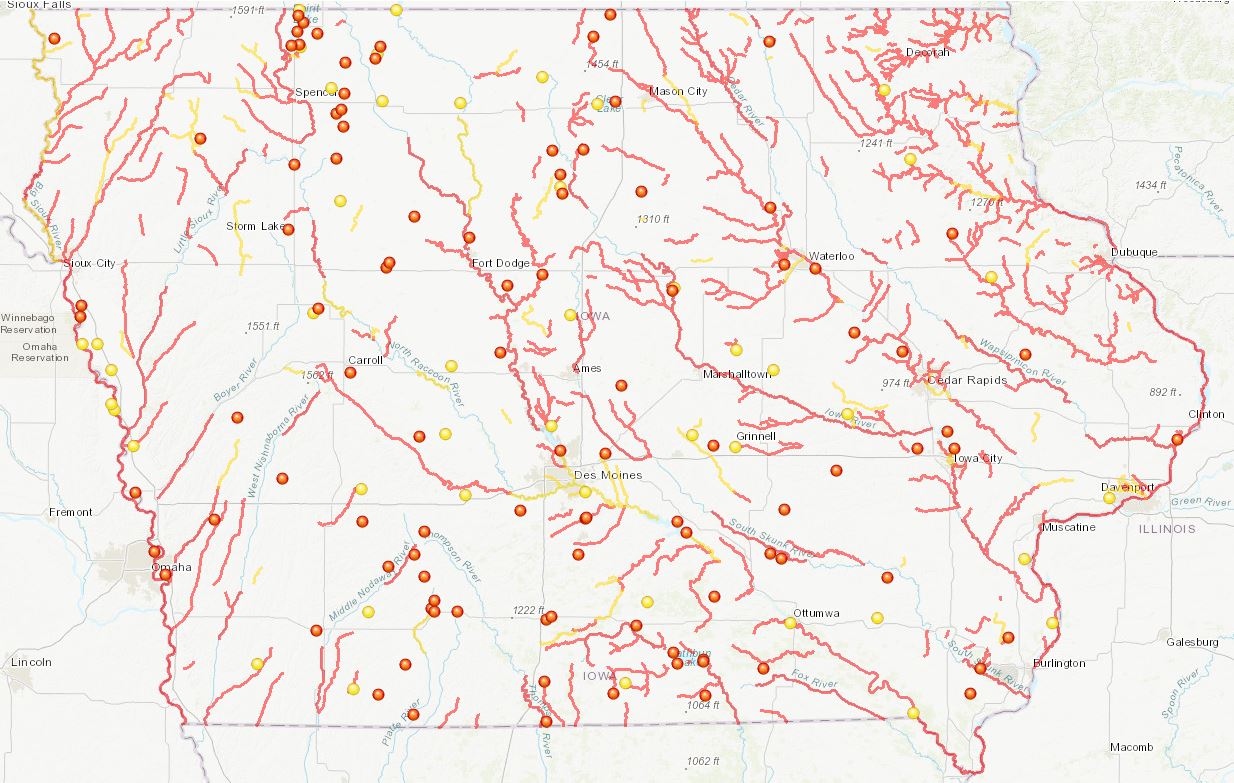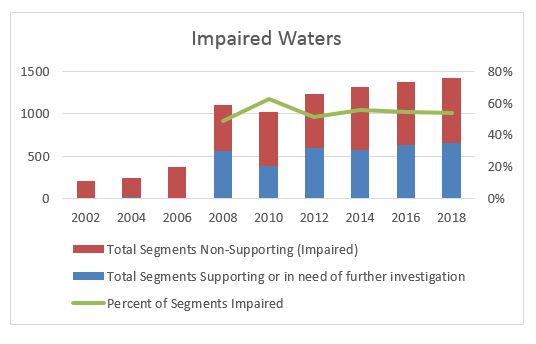Delayed 2018 Impaired Waters List Reveals Alarming Statistics
posted
on Monday, November 18, 2019
in
Water and Land News
List of Impaired Waters Only Continues to Grow
Des Moines, IA – The Iowa Department of Natural Resources released the draft 2018 303(d) Impaired Waters List for the state of Iowa on Thursday, November 14, 2019. The report, requested by the Environmental Protection Agency to be released on April 1 of even years per federal Clean Water Act requirements, is a compilation of data spanning a five-year window of 2012-2016. Iowans anticipated it to be available April 1, 2018, for comment but received it more than 19 months later.
The report finds that of the waters tested by IDNR staff for the 2018 report– more than half of the streams, rivers, lakes, and wetlands in the state – 54% are impaired for a variety of reasons such as indicator bacteria, turbidity (soil in the water), pH, and algae.
While the DNR is reporting an increase in impaired waters from 2016 to 2018 of just two percent, the Iowa Environmental Council’s review of the report concern in several areas.
“The IDNR added just 43 new segments for assessment in the 2018 report – those remaining on the list are carryovers from previous reports. Of those 43 new segments, 79% (or 34) were listed as impaired. Additionally, few waters were removed from the list for TMDL completion or water improvements. This list only continues to grow and we must call attention to the reality that we see little real progress in improving these waters,” said Alicia Vasto, IEC’s Water Policy and Advocacy Specialist.
The 2018 report lists 767 total waterbodies assessed with 1,110 impairments. The 2016 report listed 750 waterbodies with 1,096 impairments.

Interactive 2018 Impaired Waters List map, courtesy of Iowa DNR.
IEC’s analysis of the biennial lists since 2008 shows that impaired waters in Iowa are increasing as the state adds more waters to their assessment plans.
“The 303(d) list consistently shows that more than half of Iowa’s assessed waters are impaired for a designated use,” said Vasto. “We will not see a decrease in the percentage of impaired waters until the state takes the drastic steps that are necessary to clean up our waters.”

When a waterbody is added to the Impaired Waters List, the state is required to prepare a total maximum daily load plan, or TMDL, in 8-13 years. The TMDL provides a plan for reducing the causes of the impairment and returning the waterway to a state that can meet its intended use. Waterbodies are categorized for an ‘intended use,’ such as a drinking water source, recreation, or other needs.
The 303(d) list monitors waterbodies for their ability to support their intended use, but it does not assess for magnitude of impairment. DNR staff stressed in the release of the list that most of the impairments were ‘minor’ and that many Iowans still recreate in these waters without issue.
“It is important not to downplay the importance of this list. Saying that this list is ‘like going to the doctor and finding out you have high cholesterol, which isn’t going kill you but you need to monitor it’ is unfair to the Iowans who seek clean water for drinking and recreation, the businesses that rely on clean water to create and provide their products, and the children of this state who deserve a clean, healthy future. The reality is that high cholesterol can lead to a heart attack. No one wants to see more Iowa waters in an unhealthy state,” said Ingrid Gronstal Anderson, IEC’s Water Program Director.
The 2018 Impaired Waters report is now open for public comment through December 28, 2019. The IDNR encourages all Iowans who have an interest in the health of Iowa’s water to submit comments on topics such as data accuracy, interest in seeing a report on magnitudes of impairment, or other concerns. The Iowa Environmental Council will conduct a deeper analysis of the report and submit official comments before the deadline.
“We encourage Iowans to view these resources provided by the IDNR. The Council commends the staff at the IDNR for their robust monitoring and reporting, which is a significant undertaking for any state agency. Given the continued budget and staff cuts the IDNR experiences, this reporting is impressive. IEC will continue to support their efforts and call on state legislators to properly fund the DNR to allow them to expand this important work by assessing more waters and creating TMDLs in a more timely fashion,” said Vasto.
You can view the report, review a searchable database of waterbodies on the list, or view an interactive map at www.iowadnr.gov/environmental-protection/water-quality/water-monitoring/impaired-waters. Comments are due to Dan Kendall at daniel.kendall@dnr.iowa.gov at the Iowa DNR by December 28, 2019.
Comments can also be mailed to:
Iowa Department of Natural Resources Attention: Dan Kendall
Water Quality Monitoring & Assessment Section
Wallace State Office Building
502 East 9th Street
Des Moines, IA 50319
###
- clean water
- dnr
- drinking water
- water quality